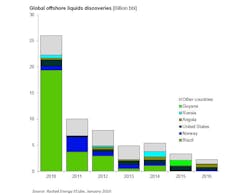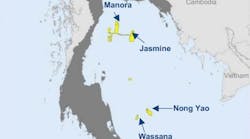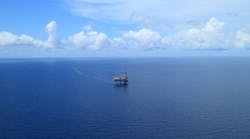Offshore staff
OSLO, Norway–New research released by Rystad Energy concluded that liquid resources discovered offshore in 2016 totaled just below 2.3 Bbbl, a figure 90% lower than in 2010. This drop is most significant to the overall decline in discovered volumes; in fact, total global discovered volumes (oil and gas combined) are at an all-time low since the 1940s.
In 2016, the average liquid content in the discovered resources was about 40%. Even more tellingly, the replacement ratio for liquids in 2016 was below 10%. For comparison, the replacement ratio for liquids in 2013 was as high as ~30%.
The analyst noted that the replacement ratio measures the amount of discovered resources during the year relative to the amount of liquids product in the same year globally. It disregards the production start-up date for the discoveries.
Rystad Energy provided some analysis around a few key countries that it believed influenced offshore discovered liquids development:
Brazil– The country experienced a new golden age thanks to multi-billion-barrel discoveries made in the beginning of this decade. Among the largest discoveries, Lula (formerly known as Tupi), Libra, and Buzios stand out. Combined, these discoveries hold around 20 Bbbl of liquids. All of the large discoveries made in Brazil in the past decade are located in the large presalt basins, especially Santos and Campos. However, the success story from 2010 did not repeat itself as 2016 approached. This is believed to be due to a combination of factors such as limited capital to develop projects that were previously discovered, or local content regulations, among others.
Norway– Exploration on the Norwegian continental shelf (NCS) showed disappointing results in 2015 and 2016, with no discovery surpassing 100 MMbbl of resources. In fact, since the discovery of Johan Sverdrup in 2011, there has not been another sizeable discovery made on the NCS, the firm reported. Exploration results were particularly discouraging given the number of exploration wells in the region, which had remained relatively stable within the range of 45 to 65 wells per year, since 2010.
US– In the Gulf of Mexico, the discovered volumes have remained relatively stable compared to the development in other offshore regions.
Russia – In Russia, the largest discovery in the past years was Universitetskaya, discovered in 2014. This discovery could potentially hold more than 2.3 Bbbl of resources, of which about1 Bbbl are liquids alone. Russia continues to be dependent on foreign technologies to be able to develop its offshore discoveries, especially in the Arctic areas. At the same time, exploration activities off Arctic regions are currently on hold due to sanctions and, generally, a decreased interest in the investment-heavy exploration due to the low oil price.
Angola – The past five years have been positive for Angola in terms of exploration results. In 2016, there were three significant discoveries made: Golfinho (operated by Cobalt International Energy), being the only large oil discovery; and Katambi and Zalophus (operated by BP and Cobalt International Energy, respectively), being the largest gas discoveries.
Guyana – Exploration results in Guyana were particularly encouraging in 2015, with a 1-Bbbl discovery. Liza was the largest oil offshore discovery that year, representing ~30% of the total offshore discovered liquids in 2015.
Rystad Energy expects the exploration activity to slowly pick up from 2018, allowing for more discoveries toward the end of this decade and beyond. At the same time, some of the recent license awards could open new prospective exploration regions, e.g. thedeepwater license award in Mexico.
01/19/2017





